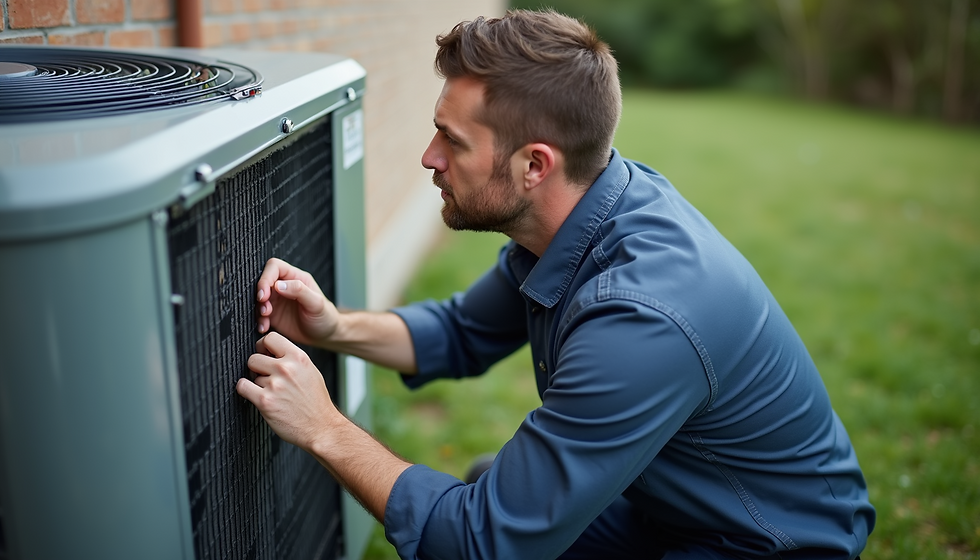Understanding the Connection Between Electrical Systems and HVAC
- Thompson Electric & Air

- Jun 6
- 4 min read
Updated: Jun 10
In the modern world, the comfort of our homes and workplaces heavily relies on two essential systems: electrical and HVAC (Heating, Ventilation, and Air Conditioning). While they serve different functions, these systems are deeply interconnected. A thorough understanding of their relationship can lead to improved efficiency, cost savings, and enhanced comfort.
What Are Electrical Systems?
Electrical systems form the backbone of a modern building. They are responsible for distributing power to various electrical appliances, lighting, and HVAC units. Key components of electrical systems include:
Power Supply: This involves the connection to the electrical grid or alternative energy sources like solar.
Wiring: Conductors that transport electricity throughout the building.
Circuit Breakers: Safety devices that prevent overloads and faults in the system.
Properly designed electrical systems ensure that all components receive the power needed for optimal function. For instance, inadequate electrical supply to an HVAC unit can lead to inefficient functioning and higher energy bills.

How Electrical Systems Power HVAC
HVAC systems require significant electrical power to operate efficiently. Understanding how they work can provide insight into optimizing their performance.
Components of HVAC Systems: HVAC systems consist of heating units, cooling units, air handlers, and ventilation systems. Each component requires electrical power—compressors, for instance, need a high starting current to operate effectively.
Power Requirements: Different HVAC units have different electrical requirements. A typical central air conditioning unit might draw between 2000 to 4000 watts, while furnaces vary widely. Matching the power supply with the HVAC unit's needs is crucial for efficient performance.
Thermostats and Controls: These devices form a crucial link between the electrical system and HVAC. Smart thermostats require low voltage power but also significantly enhance efficiency by optimizing temperature settings based on occupancy.

The Importance of Efficient Design
Efficiency in electrical and HVAC systems doesn't just save money; it also contributes to environmental sustainability. Here are some key aspects to consider:
Energy-Efficient Solutions
Investing in energy-efficient appliances can result in significant long-term savings. For example, modern HVAC systems come with higher SEER (Seasonal Energy Efficiency Ratio) ratings, which provides a metric for efficiency.
Additionally, using LED lighting instead of incandescent bulbs throughout your home can reduce electrical consumption, indirectly benefiting HVAC by lessening the heat generated within a space.
Load Calculations
Determining the correct size of your HVAC system is vital. An oversized unit can cool or heat a space too quickly without properly dehumidifying it, while an undersized unit works harder, leading to early fatigue and increased energy costs.
Performing accurate load calculations based on the square footage, insulation quality, and occupancy can ensure that your system is properly configured. Consulting with providers of electrical and HVAC services can yield personalized advice on these calculations.
Safety and Compliance
Both electrical and HVAC systems must comply with safety standards and local building codes. Failure to adhere can result in dangerous situations such as electrical fires or inefficient HVAC operations.
Regular Inspections: Conducting regular maintenance checks can spot early signs of issues. Electrical components should be inspected for fraying or exposed wires, which are fire hazards.
Licensed Professionals: Always hire certified professionals for inspections and installations. DIY methods can lead to more harm than good.
Environmental Control and Air Quality
Modern HVAC systems also improve indoor air quality. They remove pollutants, control humidity, and circulate air effectively.
Air Filters: Keeping these filters clean not only enhances air quality but also reduces the electrical load on units. A dirty filter increases resistance and makes systems work harder.
Ventilation Systems: Proper ventilation removes stale air, bringing in fresh air while keeping energy consumption low.

The Future of Electrical and HVAC Systems
Innovations are continually transforming how we interact with both electrical and HVAC systems. Some trends worth noting include:
Smart Technology Integration
Smart home technology enables the integration of electrical systems with HVAC units for optimal performance. For instance, smart thermostats can adapt to your schedule and preferences, minimizing energy use without sacrificing comfort.
Renewable Energy Sources
The shift towards renewable energy sources is changing how electrical power is supplied to HVAC systems. Solar panels, for instance, are now commonly used to power HVAC units, enhancing efficiency and cutting energy costs.
Advanced Building Management Systems
Modern buildings utilize sophisticated software that can monitor and control electrical and HVAC systems. These systems allow for better troubleshooting and can optimize energy use based on real-time data.
Practical Recommendations for Homeowners
Whether you are building a new home or upgrading your current setup, here are some practical tips to improve your electrical and HVAC systems:
Regular Maintenance: Schedule regular inspections for both electrical systems and HVAC units to catch issues before they escalate.
Invest in Modern Systems: If your system is over ten years old, consider upgrading. Modern systems are far more efficient and could pay for themselves in energy savings.
Smart Technology: Implement smart thermostats and energy-efficient lighting to reduce overall energy consumption.
By understanding the connection between electrical systems and HVAC, you can create a comfortable living environment while also promoting safety and efficiency. With proper maintenance and by staying informed about new technologies, you can ensure lasting performance and sustainability in your home or workplace.







Comments